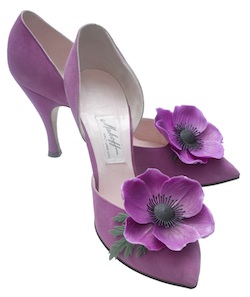In the world of women, shoes can change everything. Women lurk among department store shoe racks, touching, trying, fantasizing. This phenomenon is largely thanks to Beth Levine (1914-2006), the ambitious yet virtually unknown designer responsible for making women’s footwear fashionable in America.
“Beth Levine: First Lady of Shoes” showcases a selection of the influential designer’s shoes through June 6 at the Bellevue Arts Museum. Organized by the Dutch Leather and Shoe Museum, the exhibit is co-curated by Inge Specht, curator of the Dutch museum, and Beth Levine expert Helene Verin, a New York-based designer. BAM’s Nora Atkinson curates the local presentation.
The exhibit is the synergetic result of Beth Levine’s longtime friendships with the former chairman of the small Dutch museum, Koos Bergmans, Seattle resident Sara Little Turnbull and Verin. Now 92, Turnbull is the innovative product designer behind many of America’s domestic items. She and Levine worked closely, Turnbull revolutionizing industrial design and Levine revolutionizing fashion. After Levine’s death, Paula Rees, who manages Turnbull’s collections, mentioned to Verin that Turnbull owned 180 pairs of Beth Levine shoes (down from 600 at one point). Verin took an interest, and Rees, thinking BAM a good venue for a Beth Levine exhibition, approached the museum.
According to Atkinson, “it was a perfect fit.” The exhibit is funded in part by Nordstrom, which sells Levine’s shoes. BAM is the only U.S. venue to present the collection.
Beth Levine was the first lady of shoes in more ways than one. Not only was she an American woman in a world of European men, but her shoes also graced the feet of first ladies, including Jacqueline Kennedy’s. Her designs have been donned by Marilyn Monroe, Bette Davis and Julie Andrews, and her craftsmanship was immortalized by Nancy Sinatra’s hit, “These Boots Were Made for Walkin’.”
Levine introduced the stiletto to America and promoted the boot, mule and the pointed toe to haute couture status. She is responsible for several footwear firsts, including being the first American shoe designer to be featured abroad.
“Beth Levine: First Lady of Shoes” is broken into 13 sections, including dots and dashes, color and print, and eclectic experiments as well as several prototypes. But the exhibit is as much about shoes as it is about women’s early struggles and achievements in American industry.
Born Bessie Katz in 1914 to Jewish immigrant dairy farmers in Patchogue, N.Y., Levine moved to Manhattan in 1938, where she found work as a foot model. The practice of trying on shoes accustomed her to the comfort and functionality of a shoe as well as its aesthetic. Yet due to her gender, Levine’s opinion in matters of shoe design were disregarded.
In 1946, Beth Katz was interviewed by Herbert Levine for a designer position with Andrew Geller’s shoe manufactory. Beth landed both the job and the man: She married Herbert four months later. The couple launched their own business in 1948, called Herbert Levine, Inc. Although Beth Levine designed all the shoes, “it seemed right that a shoemaker was a man,” Herbert said at the time.
Throughout her career, Levine traveled to the ends of the earth to acquire materials, even employing the Japanese Emperor’s own embroiderers. She was the first designer to use teak and to experiment with risqué designs like transparent “vinyllite” and a full-body stocking boot. The risks Levine took speak to her anti-authority stance toward the so-called fashion police.
“If someone told her she couldn’t do it, she found a way to do it,” Atkinson says.
Modern consumers take for granted the leap that shoes, especially boots, took from functional to fashionable in the last century.
“We wanted to create a shoemaking niche,” Levine wrote. “We were making very pretty shoes that nobody needed, but everybody wanted.”
Eleven years before Andre Courreges’s Go-Go boot hit the scene, Levine had created mid-calf white kidskin fashion boots. The exhibit displays a boot-packaging insert that introduces the new concept:
“I am a fashion shoe…called a Boot,” reads the description at the exhibit. “I was created to be soft, light, elegant and divinely comfortable.”
If any doubt about Levine’s intrepidness remains, simply behold the “Marlene Boot” — a thigh-high boot attached to a garter belt — designed for Marlene Dietrich’s legs.
While many of Levine’s designs marry style and practicality, others capture her whimsical imagination. The exhibit displays1960s-inspired designs like paper shoes, a shoe made out of space suit material and a sandal lined with Astroturf, “so the grass goes with you.”
“Paper shoes?” she once said. “Oh that was just done for fun! Sometimes shoes are just fantasy, really.”
BAM also features her famous “no shoe,” a sole and heel that attaches to the foot with adhesive.
Levine’s shoes, some of which were inscribed with the wearer’s name, were a labor of love. In a 1969 New York Post interview, Levine said, “with so few things real, like the taste of orange juice, there is a longing for quality.”
However, in 1975 Herbert Levine, Inc. closed its doors due to the rising cost of production, the increasing popularity of the sneaker, and the public’s declining interest in designer shoes. Levine’s name has since been overshadowed by industry giants, yet her reputation as a revolutionary in the world of shoes lives on in high fashion circles and, for a limited time, in Bellevue.
“˜Sometimes shoes are just fantasy’
